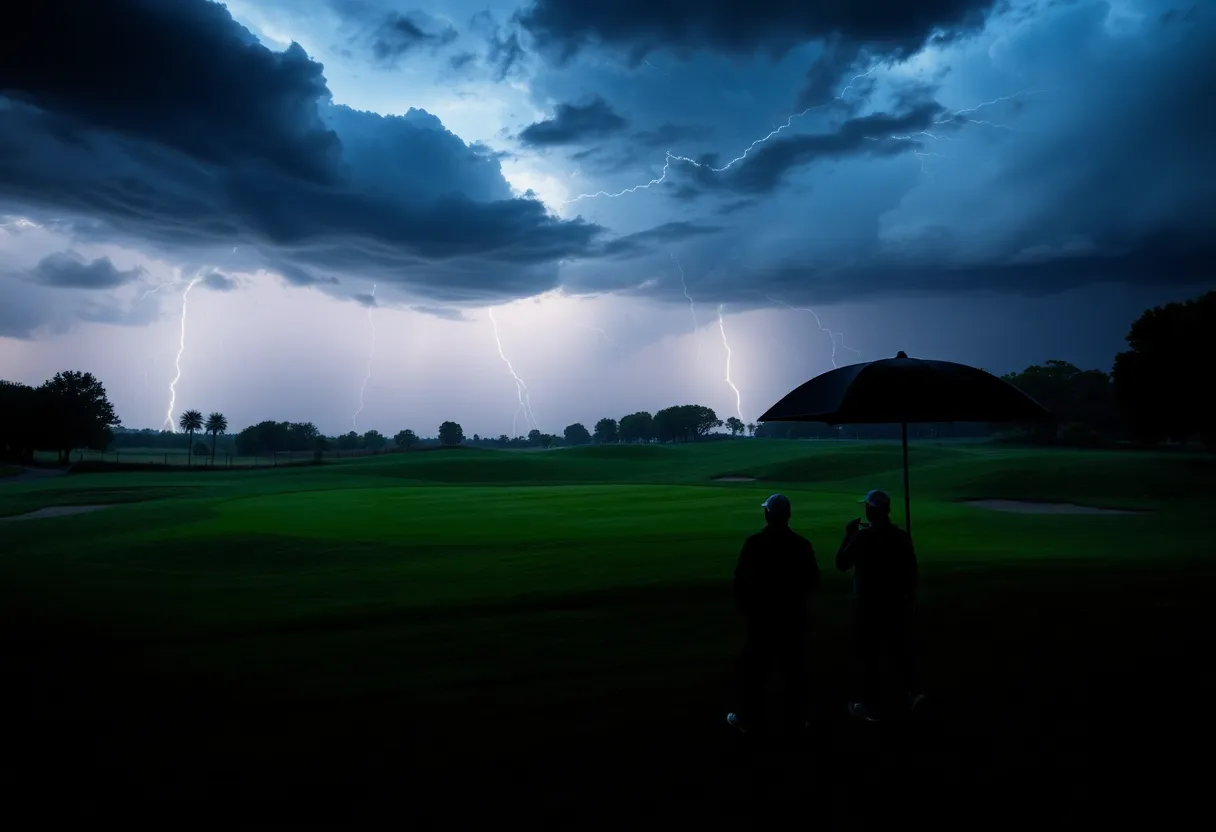,Florham Park, New Jersey, August 19, 2025
News Summary
A 36-year-old golfer was struck by lightning while playing at the Pinch Brook Golf Course in Florham Park. The incident occurred amidst thunderstorms, leading to immediate CPR by bystanders and first responders. He was transferred to Cooperman Barnabas Medical Center in critical condition. This marks the second lightning-related incident involving a golfer in New Jersey in recent weeks, sparking concerns regarding safety measures on the courses. Local authorities are emphasizing the importance of awareness and preparedness during thunderstorms.
Florham Park — Golfer in Critical Condition After Being Struck by Lightning at Pinch Brook
A quiet evening on the course turned chaotic just after 6:00 p.m. on Sunday, August 17, when a 36-year-old man was struck by lightning at the Pinch Brook Golf Course in Florham Park, New Jersey. The strike happened while thunderstorms rolled through the area, with the golfer reportedly hit between the 2nd and 16th holes, sending fellow players and bystanders into immediate action.
Fast action on the fairway
After the lightning strike the man stopped breathing, lost consciousness and went into cardiac arrest. Nearby golfers and bystanders — including a veteran member of the Florham Park First Aid Squad — began CPR right away. First responders arrived quickly and were able to revive him on-site before rushing him by ambulance to Cooperman Barnabas Medical Center in Livingston. His condition was reported as critical following the transfer, and further updates were not immediately available.
Why this feels like déjà vu
This frightening episode is the second lightning strike involving a golfer in New Jersey within just a few weeks. On July 8, 2025, 28-year-old Simon John Mariani was struck at Ballyowen Golf Course and died from his injuries several days later. In another tragic July case, 61-year-old Robert Montgomery was killed at an archery range in Jackson Township during a lightning event, and several other people — including children — were injured.
Broader numbers and the local response
The National Weather Service has recorded at least 13 lightning-related fatalities in the United States in 2025 so far, including the two incidents in New Jersey. Despite the recent cluster of high-profile events, the odds of any one person being struck in a given year remain very low — less than 1 in a million, according to the National Weather Service — and the country averages about 27 lightning strike fatalities annually. From 2006 through 2023, the U.S. saw 444 lightning deaths, with 2016 the deadliest single year at 40 fatalities.
Local authorities praised the quick intervention of bystanders at Pinch Brook. Officials noted that immediate CPR and fast work by first responders likely made the difference between life and death.
New safety steps and what golfers should know
In light of recent fatalities, some municipalities in New Jersey have started to roll out more visible safety measures. A new weather alert system has been implemented in several parks in Paterson, and courses and outdoor recreation sites are being urged to review storm-response plans. Golfers — who spend long stretches out in open areas and may not hear approaching thunder until it’s close — need to be especially alert to changing weather and ready to seek shelter.
As an expert golf writer who spends time around courses and talking with players and staff, this kind of event is a stark reminder that even routine rounds can turn dangerous when storms move in. Carry weather apps, know where the clubhouse or other sturdy shelter is, and never assume a quick shower won’t escalate. Lightning can strike miles from the head of a storm, and the seconds you gain by leaving the fairway early can be life-saving.
Quick takeaways for players
- If you hear thunder, act: Move to shelter immediately — a car or fully enclosed building is best.
- Don’t wait for rain: Lightning can strike before you see heavy precipitation.
- Have a plan: Know the nearest shelter on every hole you play and keep an eye on the sky.
- Learn CPR: Immediate chest compressions save lives; a bystander’s response matters.
Where the golfer was taken
The injured player was transported to Cooperman Barnabas Medical Center in Livingston for treatment. Further medical details were not made public immediately, and authorities continue to investigate the exact circumstances of the strike.
FAQ
How common are lightning strikes for golfers?
Lightning strikes on golfers are rare but not unheard of. The odds of being struck in a given year are less than 1 in a million, yet golf courses expose players to open areas where bolts can hit. The U.S. averages about 27 lightning fatalities a year.
What should I do if a storm moves in while I’m on the course?
Stop play immediately and move to a safe shelter — a fully enclosed building or a car with the windows up. Avoid small shelters, tall isolated trees, and open water. If no shelter is available, get low, crouch with feet together, and minimize contact with the ground — but know that shelter is far preferable.
What if someone is struck by lightning?
If someone is struck, call 911 immediately. Check for breathing and pulse. If they’re not breathing or have no pulse, start CPR and use an AED if one is available. Lightning victims do not carry an electric charge and are safe to touch for rescue.
Are courses doing anything new after recent incidents?
Some parks and facilities have started installing automated weather alert systems and boosting signage about storm safety. Course managers are being advised to have clear emergency action plans and to communicate weather policies to players.
Quick Reference Table — Lightning & Golf Safety
| Topic | What to Know | Action for Golfers |
|---|---|---|
| When to stop play | At the first sound of thunder or flash of lightning, storms can be nearby. | Head to shelter immediately; do not finish the hole. |
| Best shelter | Fully enclosed buildings or metal-roofed cars with windows up. | Get inside and stay until 30 minutes after last thunder. |
| If someone is struck | Victims are safe to touch; they do not hold charge. | Call 911, start CPR if unresponsive, use AED if available. |
| Local hospital | Cooperman Barnabas Medical Center (Livingston) received the recent patient. | Emergency transport typically goes to nearest trauma-capable facility. |
| National context | U.S. averages ~27 lightning deaths per year; 13 recorded in 2025 so far. | Respect storms; risk is low but consequences are severe. |
As a golf writer who sees the game from the clubhouse to the course corners, my advice is simple: treat thunder like the bell that ends play. It’s the fastest, surest way to keep your round from turning into a tragedy.
Deeper Dive: News & Info About This Topic
HERE Resources
Additional Resources
- ABC7 NY
- Wikipedia: Lightning
- CBS News
- Google Search: golfers struck by lightning
- NBC New York
- Google Scholar: lightning safety for golfers
- New York Post
- Encyclopedia Britannica: lightning strikes
- Golfweek
- Google News: lightning golf safety
Author: STAFF HERE BOSTON WRITER
The BOSTON STAFF WRITER represents the experienced team at HEREBoston.com, your go-to source for actionable local news and information in Boston, Suffolk County, and beyond. Specializing in "news you can use," we cover essential topics like product reviews for personal and business needs, local business directories, politics, real estate trends, neighborhood insights, and state news affecting the area—with deep expertise drawn from years of dedicated reporting and strong community input, including local press releases and business updates. We deliver top reporting on high-value events such as Boston Marathon, Head of the Charles Regatta, and Boston Harborfest. Our coverage extends to key organizations like the Greater Boston Chamber of Commerce and Associated Industries of Massachusetts, plus leading businesses in finance, biotech, and insurance that power the local economy such as Fidelity Investments, Biogen, and Liberty Mutual Insurance. As part of the broader HERE network, we provide comprehensive, credible insights into Massachusetts's dynamic landscape.





